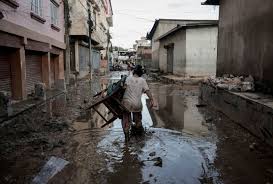Nepal Devastated by Deadly Flash
Nepal is grappling with the aftermath of one of the most destructive natural disasters in its recent history. In late September 2024, relentless monsoon rains triggered severe flash floods and landslides across the country, with the central and eastern regions being hardest hit. The capital, Kathmandu, witnessed an unprecedented deluge, leading to the death of at least 226 people and leaving hundreds displaced as homes were submerged and roads washed away. The weekend of September 26-28 saw record-breaking rainfall—the heaviest monsoon downpour in two decades—which quickly overwhelmed Nepal’s fragile infrastructure. Rivers swelled beyond their capacity, with the Bagmati River, which flows through Kathmandu, spilling into neighborhoods and turning streets into raging torrents. This flooding rendered many parts of the city inaccessible and overwhelmed emergency services.
Rescue teams have been working tirelessly to evacuate people from flooded areas, while the government has declared a state of emergency in the worst-affected regions. Thousands of homes have been destroyed, and essential services such as electricity and clean water have been severely disrupted. As of now, relief efforts are in full swing, though access to remote areas remains a significant challenge due to damaged roads and landslides blocking key routes. Experts attribute the intensity of these floods to a combination of poor urban planning, climate change, and deforestation. Nepal, a country largely reliant on agriculture, has seen increased vulnerability to climate-induced disasters over recent years. The government is facing mounting pressure to address these issues, as climate experts warn that such extreme weather events are likely to become more frequent in the future.
Nepals Government Failed Actions
The devastating flash floods in Nepal have raised serious questions about the government’s preparedness and response to natural disasters, highlighting critical shortcomings in infrastructure, urban planning, and emergency management. Despite being situated in a region prone to such disasters, the government of Nepal has repeatedly failed to implement effective measures that could mitigate the impact of extreme weather events.
One significant instance of negligence lies in the country’s inadequate drainage systems. Kathmandu, a city with a rapidly growing population, has not invested sufficiently in upgrading its aging infrastructure to handle increased rainfall. Urban planning has often prioritized short-term development over long-term sustainability, leading to the construction of buildings and roads without proper consideration for their impact on natural water flow. Experts argue that if the government had prioritized modernizing drainage systems and implementing comprehensive land-use regulations, the extent of flooding could have been significantly reduced.
Moreover, deforestation and poor land management practices have exacerbated the situation. The government’s failure to enforce environmental regulations has led to widespread illegal logging, which not only diminishes the land’s natural ability to absorb rainfall but also increases the risk of landslides. Many critics point to the Minister of Forests and Soil Conservation’s, Hon’ble Ain Bahadur Shahi Thakuri, and the ministry as a whole lack of action in addressing these issues, arguing that more stringent enforcement of existing laws could have helped preserve vital ecosystems that mitigate flooding.

Additionally, the Nepalese government’s emergency preparedness has come under scrutiny. In the days leading up to the floods, meteorological warnings were issued, yet the government did not effectively mobilize resources or communicate with citizens about the potential dangers. The lack of a coherent disaster response plan and insufficient training for emergency responders left communities vulnerable and ill-prepared for the impending crisis. This has raised serious concerns about the leadership of the Minister of Home Affairs, who has been criticized for the ministry’s inadequate disaster management strategies. As the nation begins to recover from this tragedy, calls for accountability are growing louder. Many citizens are demanding that the government take responsibility for its failures and implement reforms aimed at improving disaster resilience. This situation has ignited a broader conversation about governance in Nepal, emphasizing the urgent need for a more proactive approach to environmental management and disaster preparedness.
The recent floods are not merely a natural disaster; they expose systemic failures within the government that could have been prevented with timely and effective action. The people of Nepal are left to wonder whether their leaders will finally heed the warnings and take the necessary steps to protect their communities from future catastrophes.
In the wake of this disaster, international aid has begun to pour in, but much more is needed to help Nepal rebuild. With thousands displaced and the economy already struggling, the long-term recovery will require substantial efforts both domestically and globally. The question now is whether Nepal can learn from this catastrophe and build resilience against future disasters.








